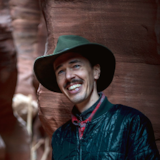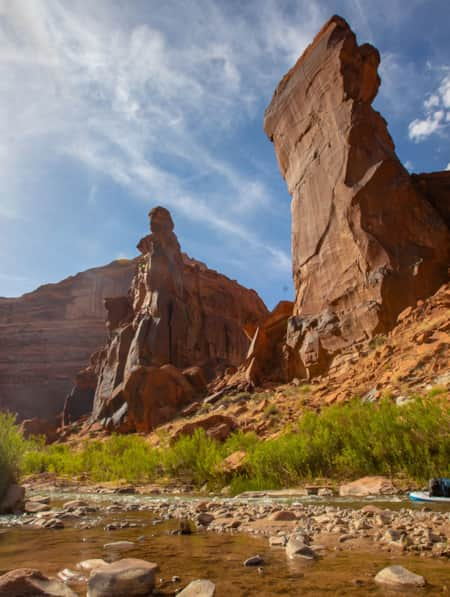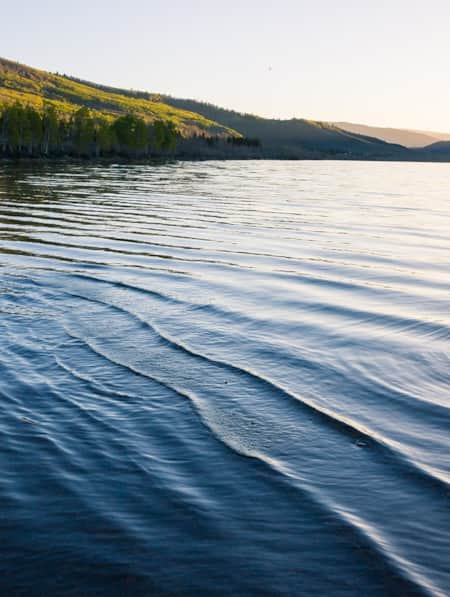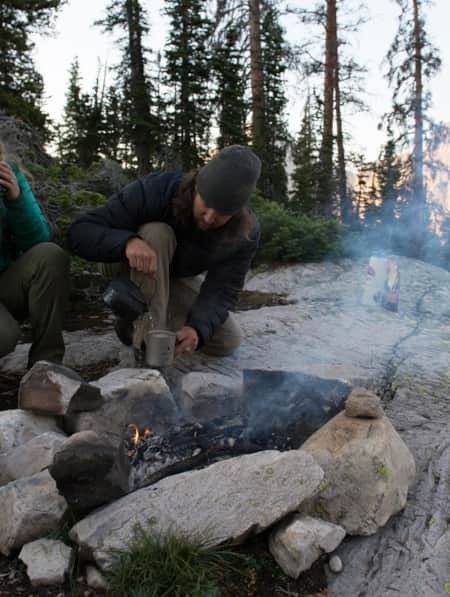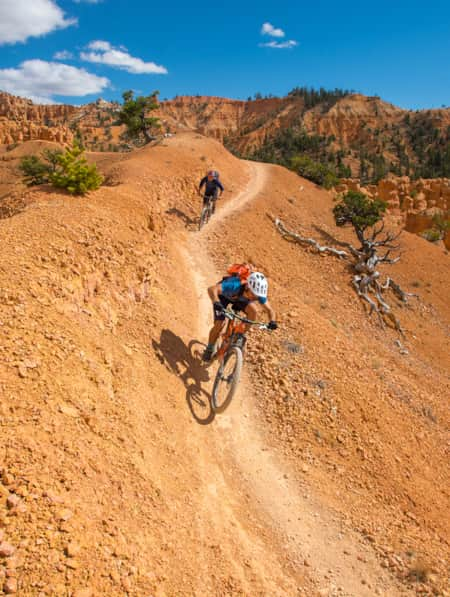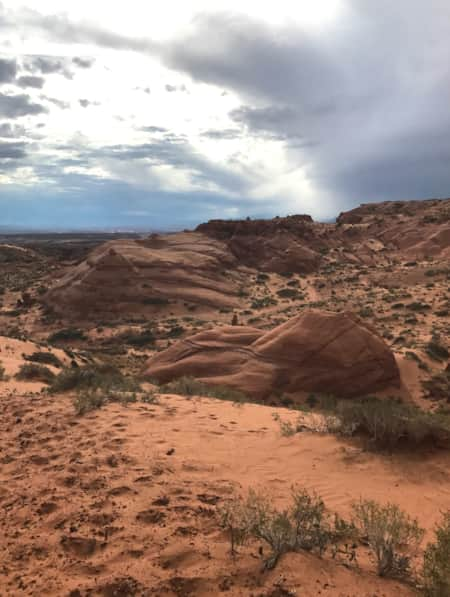High, Lonesome Wilderness: Backpacking the High Uintas
Pursue solitude, extended moments of introspection, cutthroat trout and the Milky Way.
Stillness permeates the High Uintas. It’s dark now. Not dark as in, the sun has set. Astronomically dark. The moon has set. It’s so quiet. It’s 4 a.m. quiet. Night had come on in a show of wind, lightning and a fiery sunset that burned up a distant ridgeline until its charcoal remains scattered into the void. Far-off thunder didn’t exactly crack and boom; it rolled and ricocheted across the vastness of the Utah wilderness while a few gentle drops of rain fell harmlessly on camp. In that earlier moment, it was boisterous as the rye passed around the fire, working in conjunction with the fire to fend off the creeping chill of 10,000 feet, as August rolled into September.
But now, when the wind does blow, it is as if by accident.
My own movement in my mummy bag feels like a disturbance. My eyes are flickering, willing my mind to detach from my awakening senses and my body to return to sleep.
Unzipping the tent feels like breaking a promise to the night. I do it slowly, gradually, like I don’t want my parents in the room across the hall to hear, like I’m five. (I’m actually the furthest from the main camp where the rest of our group is set up.)
The zipper on the rainfly comes next. It’s even worse: the exterior wall. I imagine a black bear asleep right outside. She’s stopped to contemplate my camp then drowsily fallen asleep. But I’m looking for a lesser bear.
I get my head out and crane my neck. I glimpse Ursa Minor and the North Star almost by accident. And then, there — definitely. A rough band of translucent white streaking overhead and disappearing behind a stand of pine and the rocky backdrop of Kamas Lake: It’s the Milky Way.
Becoming Self-Sufficient
“Add 1 minute for every one thousand feet above 5,000. So, five extra minutes?”
After a day hauling gear — shelter, food, camera batteries — the camp has settled in around multiple JetBoils and pouches of freeze-dried dinner. Five minutes on top of 15 feels like a long time for food after even a couple of miles carrying so much weight. I’ve already gotten started on my Canyon Chicken Chili when photographer Matt Hage strategically sets his dinner pouch on the rim of the fire pit to help keep warm during the long rehydration.
“That’s a pro tip,” I joke.
Pro tips bounce around camp like mosquitos. I’m particularly interested to learn from Cindi and Zach Grant, both around 30, who are making a life and a living out of the backcountry.
Zach wears a goatee, and his long, dark hair falls around his shoulders from underneath his beanie. He smiles easily and exudes a zen-like quality of being in his element. Equally at comfort, Cindi appears confident and measured, with long, blond hair, soft features and a knack for well-deployed curse words that are never harshly uttered or accented. Both speak with soft, gentle tones that could probably set a charging moose at ease and would be equally at home in the studio of Bob Ross or NPR.
Some tips will become immediately relevant to our adventure: Stuff your isobutane gas canisters into something overnight because the gas will begin to separate at around 40 degrees Fahrenheit, making cold starts in the morning difficult. Other tips we file away for future adventures: When cooking in true bear country, change out of cooking clothes and add those to your bear-proof canisters, and don’t use the fire to burn food and packaging scraps. (More tips: Backpacking in Utah)
The conversation turns to fishing as Zach recounts recent travels, swapping the pursuit of graylings in Alaska earlier in the year for 5-pound goldens in the Wind River Range where they recently returned from a 110-mile traverse, accompanied by their dog, Yoda Bear. Our hope is to pull some cutties, brookies or tigers (types of trout) from these high-alpine lakes. Cindi teases her go-to backcountry seasoning and I’m interested to see how their preparation methods compare to my own. (Discover: Fly Fishing the Uinta Mountains)
As they tell it, Zach and Cindi have been running together for about 15 years. They started snowboarding together at Brighton Ski Resort as teenagers, and have built an identity and brand on Backcountry Living.
“For me,” says Zach, “It’s the most quality life: the focus on air, water, solitude — the peace and quiet. I’m not anti-social by any means. I do enjoy the company of friends and value those moments. But out here, it’s a little slower pace.”
Adds Cindi, “It’s a lot easier to be present when you’re outside. All your senses are on and you have to be in the moment.”
"It’s a lot easier to be present when you’re outside. All your senses are on and you have to be in the moment."
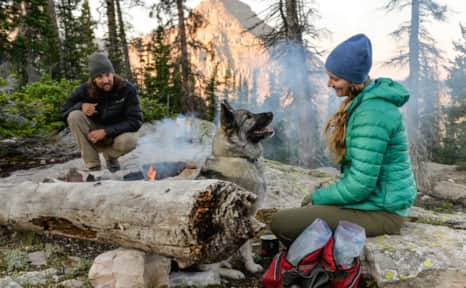
Breakfast beg in the High Uinta Wilderness.
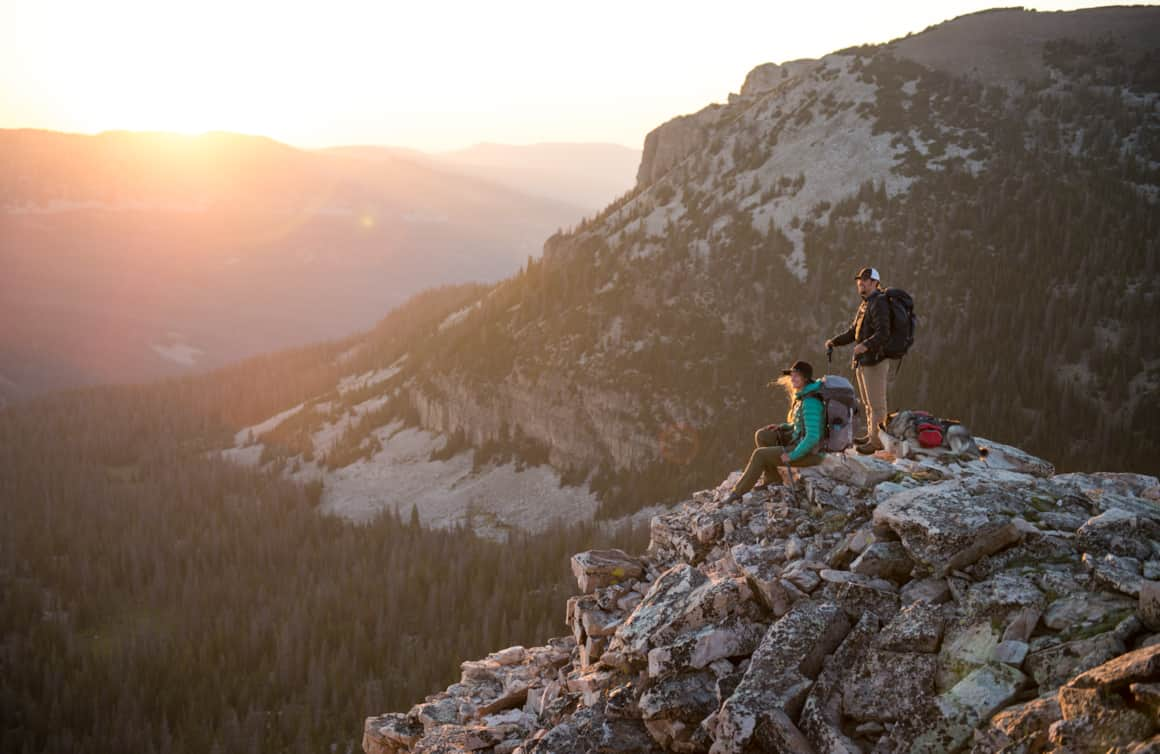
The culmination of so much outdoor experience over so many years imbues every moment with purpose for Cindi and Zach.
“You go see a range, see an aspect and it sparks a real curiosity. We ask, ‘What’s on the other side? Where does that river go?” Zach asks.
Such curiosity turns into projects for the Grants the way most of us create checklists for things we hope to accomplish around the house. The Grants’ list of ongoing projects reads, well, a little differently: Wasatch/Uintas, Alaska, Wind River. There are unknowns even within familiar places. If they’ve seen three sides of a mountain, that leaves a fourth. For the Grants, when you see the fourth side you see a whole other mountain. What would they learn by following the path of their curiosity? Curiosity matched with backcountry know-how reveals new angles on landscapes; it takes you to places people don’t normally get to see and to lakes people don’t normally get to fish. Self-sufficiency takes practice, but it can be very rewarding.
It’s why I’m here: practice.
Sense of Place
Backpacking can be very social, but it can feel solitary, introspective. Deep into a hike, the conversation will waiver and fade as the group spreads out a little and the mind shifts away from the everyday preoccupations and toward the present moment, toward each step as you ascend or descend, the weight of your pack a constant presence. And that’s not to mention you don’t notice the effective oxygen situation quite so much until you try to sustain a conversation on an incline between 10,000 feet and 10,700 feet above sea level. If you’re lucky, some sense of the bigger picture will seep in as you recognize your place within wild nature and you focus with more precision and clarity on what’s around you.
Maybe it’s the low air pressure.
Still, there’s so much to take in. Bald Peak and Reeds stand like sentinels to the southwest, part of the east-west oriented High Uintas, Utah’s highest mountain range. It was learning about the Uinta Mountains in Roadside Geology of Utah that I was reintroduced to the term “orogeny.” Mountain building. Uplifting occurred on vertical faults and a relatively young mountain range was born of a very old rock formation along an east-west orientation dating to a basin formed hundreds of millions of years ago on a supercontinent called Rodinia.
As it happens, this used to be a glacial ice cap. Far as the eye can see.
Is that the bigger picture seeping in?
I tune back into some discussion around identifying scat when someone asks if there are moose or elk up here. (There are.) There are also cattle.
In pursuit of some extra solitude, I branch off from the main group, returning to the steep spur trail that descends to Cutthroat Lake. Cutthroat proves immediately true to its name: I think I see the unmistakable little dark spots on a couple of cutties cruising the shallows and feeding on the water skeeters, though when I return with the group the next day we see mostly brook trout and nothing bites. Cutthroat Lake is a little larger and a little deeper than Lofty Lake in a glacially eroded valley. The space around it would make a nice secluded overnight option once the echoes from weekend foot traffic on the Lofty Lake trail a few hundred feet up subside. Lofty Lake itself is a glacial-fed, unstocked lake at 10,700 feet. It’s a stop, really, on the namesake trail, a midpoint to fill up the water bottle (which I did, filtered and UV-zapped) or reflect for a few minutes, catching your breath after an ascent at this elevation.
The meadows here flash a gradient of yellow, vibrant green, crimson red and a crumbling wall of rock lines the backdrop. There is grazing up here, which explains the minimal wildflowers. But we do see fireweed, white yarrow, black currant, wild raspberry, milk thistle. I’m told the leaves of yarrow are an antiseptic and milk thistle is a liver cleanser.
"What do we mean when we say 'backcountry,' anyway? Given our increasing connectivity, how far do we have to travel to get there?"
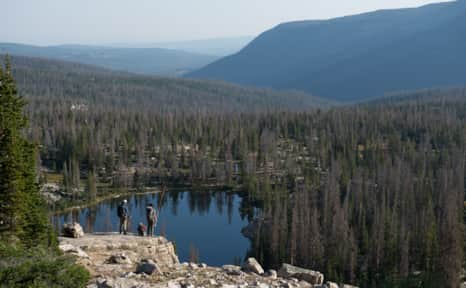
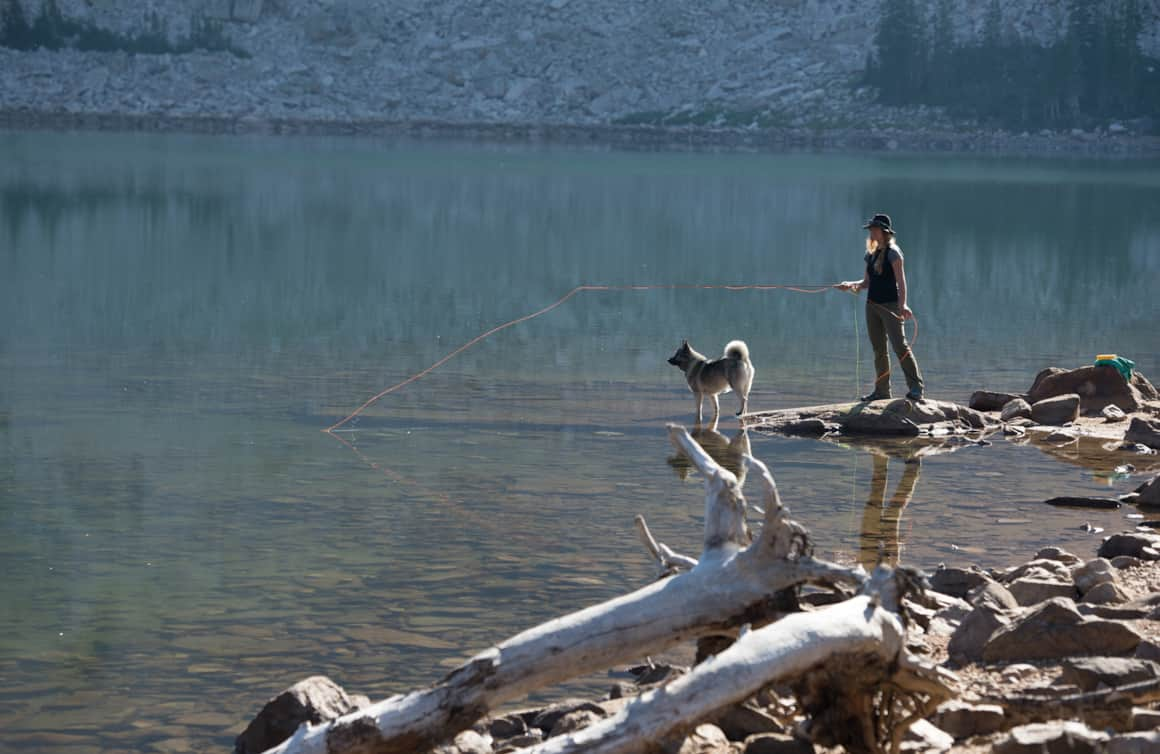
The Great Disconnect
Yoda Bear is a Norwegian elkhound. They are friendly, independent working dogs that I’m told were bred for stamina. Yoda had recently accompanied the Grants on a 110-mile traverse of the Wind River Range in Wyoming, so clearly it is not an exaggeration. While we fish Kamas Lake, Yoda takes off on his own on a circumnavigation of the lake. I watch as Yoda becomes a tiny dot on the opposite shoreline, equally at home in the backcountry as his humans.
When we reassemble at camp, Zach calls once for Yoda, and a few minutes later he wanders in. Yoda lives up to his breed, but come bedtime, he is more than ready to call it a day, and is confused when the videographer wants to light up the tent to stand out against the deepening sky.
That second night, I welcome the opportunity to climb back into my sleeping bag. I had occupied nearly all daylight hours hiking between Kamas, Lofty and Cutthroat lakes and fishing the shores of Kamas. Call it like it is: I was dog tired.
At the trailhead the first day, I had turned the data off my phone so the battery stayed strong through the second night, at which time I decided I had best charge it back up. I dug out my battery charger, but soon realized I had gotten away without the adaptor for this phone. I felt momentary alarm and disappointment, but also realized it was near the last thing I needed to worry about forgetting out here. I shut down my phone and went about settling in for the night. I would go to sleep knowing I would have to wake up on my own terms tomorrow morning. What I didn’t anticipate was how different the hiking would be without giving into the compulsory need to stop and take pictures of everything along the way. I barely ever knew what time it was.
What do we mean when we say “backcountry,” anyway? Given our increasing connectivity, how far do we have to travel to get there?
After only two miles, we’ve hiked twice as far as Henry David Thoreau when he went to Walden Pond in pursuit of solitude. We’ve gone deliberately. By some measure, it’s not precisely “wild,” up here, at least not in the sense of “uncharted territory.” But wilderness is all around us. It is touchable. A profound disconnect can be achieved. We don’t take being here lightly nor set foot casually. A reverence for wild spaces pervades. The thought of wilderness creates a feeling of expectation, gives definition to where you’ve come from while teaching you the vocabulary of where you are going.
Up here in the High Uintas it is a quieter place, at times a lonesome wilderness, but we do not feel alone. Wilderness areas are a gift from our predecessors, passed down like an heirloom. Like an heirloom, these areas are to be treasured, for a story permeates them. Sometimes heirlooms are better left untouched, appreciated for what they hold intrinsically rather than for any interactional or transactional value. Once you’re old enough or mature enough, it will be yours. This is not to say that wilderness must only sit high on a shelf out of reach, but how and how often we use it is worth the meditation. Sometimes a change in mindset or worldview is required before we can understand what we have inherited.
Being There
Working as a team, Zach dresses the lone, but surprisingly hefty, cutthroat pulled from Kamas Lake and holds it open while Cindi sprinkles in their house seasoning salt (lemon pepper, garlic, powdered butter) and loads it with dried rosemary, which along with the garlic, Zach painstakingly cultivates from their home garden at 8,500 feet above sea level. They then sprinkle the outside of the fish with the seasoning and wrap it tightly in two layers of foil, which Cindi had carefully unfolded for the job. Foil is light, packs small, and makes backcountry cooking a snap. It’s my go-to method as well.
Many camping trips, car camping and backpacking alike, culminate in those moments when the sun sets and the fire is burning hot. How you use this time is up to you. Families break out the marshmallows and the adults, perhaps, something stronger: if it’s warm, beer kept cold in the lake; if it’s colder outside, whiskey. It’s time for the ghost stories or remembrances of times past. Flames lapping the horizon spur emotions ranging from anticipation to reflection.
The parking lot is full when we return to the trailhead — overflowing. I had hiked the Lofty Loop Trail and the Cutthroat spur at least twice during our visit. As we descended the Mirror Lake Scenic Byway, I could see that the aspens were starting to change as patches of yellow popped on the hillside at around 8,000 feet. One mile up from the Cobblerest Campground, the valley warmth began creeping into the rolled-down windows of our SUV.
It’s Sunday, and the byway is heavily populated with escapees from the nearby metropolitan area of Salt Lake City and the Wasatch Front. These roadside lakes and more developed campgrounds are a different experience from primitive camping. Even Lofty Lake, barely backcountry by the Grants’ standards, permits long stretches of solitude — and presents options for well-prepared hikers to push even further afield. But it doesn’t really matter in the end. The key is being here.
During a somewhat “busy” stretch of the late morning on a Saturday, I was fishing the bank of Kamas Lake looking for new points to cast. As a couple passed along the trail a few feet up from the water’s edge, I overheard a woman say, “For heaven’s sake I never camped until I came to Utah. Never camped in California. What’s the point of camping if you can’t even see the stars?”
I do think seeing the stars is important. But I keep thinking about the fourth side of the mountain, too. Zach and Cindi have learned to travel light and efficiently and have a certain knack in the backcountry that comes from experience. But as we talked about some of the projects they have tackled and what they draw from them, something remained constant: “You still experience all the emotions climbing something unknown — awe, wonderment — but you absolutely have to push off your comfort zone to get there. And there’s a lot of happiness and fulfillment out of doing that,” Zach says.
Cindi is nodding in agreement and I ask what she gets out of it. She picks her word:
“Satisfaction.”
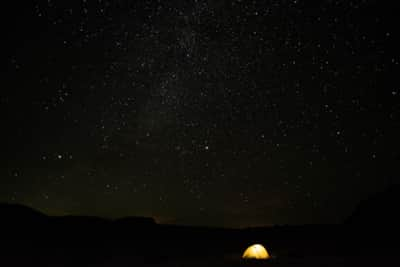
What's Nearby
-

Bald Mountain Summit
Bald Mountain is one of the highest peaks in the western Uinta Mountains. The short and steep two-mile trail has made it one of Utah’s best hikes. See how tall it is.
-

Kamas
Kamas is a quiet high country town with a population of around 2,000 people and a ranch mentality from the earlier settlements. Today, it's defined by vast tracts of open space, access to recreation and family friendliness.
-

Mirror Lake Scenic Byway
You’ll never forget your drive on the Mirror Lake Scenic Byway. This 42-mile stretch of road passes through the gorgeous Uinta Mountains. Check it out!
